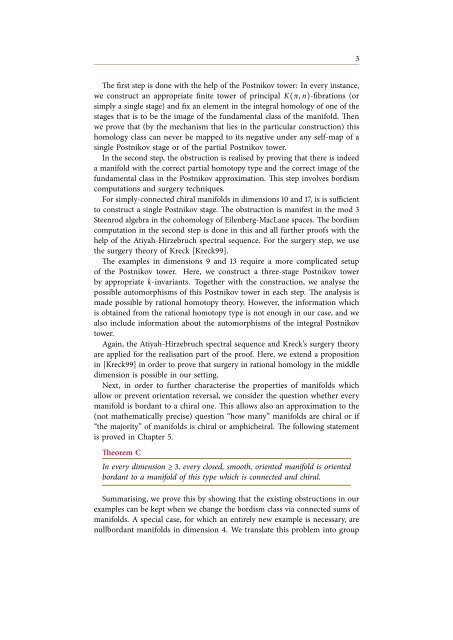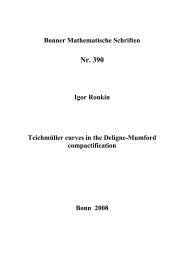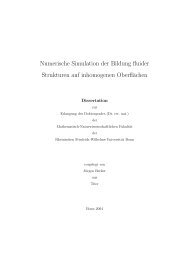Orientation reversal of manifolds - Universität Bonn
Orientation reversal of manifolds - Universität Bonn
Orientation reversal of manifolds - Universität Bonn
Create successful ePaper yourself
Turn your PDF publications into a flip-book with our unique Google optimized e-Paper software.
3<br />
The first step is done with the help <strong>of</strong> the Postnikov tower: In every instance,<br />
we construct an appropriate finite tower <strong>of</strong> principal K(π, n)-fibrations (or<br />
simply a single stage) and fix an element in the integral homology <strong>of</strong> one <strong>of</strong> the<br />
stages that is to be the image <strong>of</strong> the fundamental class <strong>of</strong> the manifold. Then<br />
we prove that (by the mechanism that lies in the particular construction) this<br />
homology class can never be mapped to its negative under any self-map <strong>of</strong> a<br />
single Postnikov stage or <strong>of</strong> the partial Postnikov tower.<br />
In the second step, the obstruction is realised by proving that there is indeed<br />
a manifold with the correct partial homotopy type and the correct image <strong>of</strong> the<br />
fundamental class in the Postnikov approximation. This step involves bordism<br />
computations and surgery techniques.<br />
For simply-connected chiral <strong>manifolds</strong> in dimensions 10 and 17, is is sufficient<br />
to construct a single Postnikov stage. The obstruction is manifest in the mod 3<br />
Steenrod algebra in the cohomology <strong>of</strong> Eilenberg-MacLane spaces. The bordism<br />
computation in the second step is done in this and all further pro<strong>of</strong>s with the<br />
help <strong>of</strong> the Atiyah-Hirzebruch spectral sequence. For the surgery step, we use<br />
the surgery theory <strong>of</strong> Kreck [Kreck99].<br />
The examples in dimensions 9 and 13 require a more complicated setup<br />
<strong>of</strong> the Postnikov tower. Here, we construct a three-stage Postnikov tower<br />
by appropriate k-invariants. Together with the construction, we analyse the<br />
possible automorphisms <strong>of</strong> this Postnikov tower in each step. The analysis is<br />
made possible by rational homotopy theory. However, the information which<br />
is obtained from the rational homotopy type is not enough in our case, and we<br />
also include information about the automorphisms <strong>of</strong> the integral Postnikov<br />
tower.<br />
Again, the Atiyah-Hirzebruch spectral sequence and Kreck’s surgery theory<br />
are applied for the realisation part <strong>of</strong> the pro<strong>of</strong>. Here, we extend a proposition<br />
in [Kreck99] in order to prove that surgery in rational homology in the middle<br />
dimension is possible in our setting.<br />
Next, in order to further characterise the properties <strong>of</strong> <strong>manifolds</strong> which<br />
allow or prevent orientation <strong>reversal</strong>, we consider the question whether every<br />
manifold is bordant to a chiral one. This allows also an approximation to the<br />
(not mathematically precise) question “how many” <strong>manifolds</strong> are chiral or if<br />
“the majority” <strong>of</strong> <strong>manifolds</strong> is chiral or amphicheiral. The following statement<br />
is proved in Chapter 5.<br />
Theorem C<br />
In every dimension ≥ 3, every closed, smooth, oriented manifold is oriented<br />
bordant to a manifold <strong>of</strong> this type which is connected and chiral.<br />
Summarising, we prove this by showing that the existing obstructions in our<br />
examples can be kept when we change the bordism class via connected sums <strong>of</strong><br />
<strong>manifolds</strong>. A special case, for which an entirely new example is necessary, are<br />
nullbordant <strong>manifolds</strong> in dimension 4. We translate this problem into group





